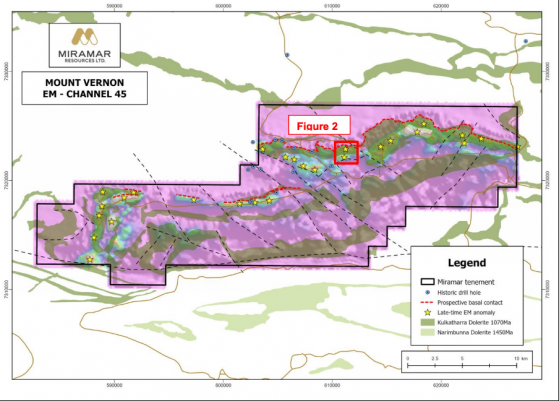Miramar Resources Ltd (ASX:M2R) will hit the ground running with a drill program at its Mount Vernon nickel-copper-platinum group element (PGE) project in WA’s Gascoyne after securing a pivotal program of work (POW) approval.
The explorer will move in with reverse circulation or diamond drilling, aiming to test electromagnetic (EM) geochemical anomalies linked to the Kulkatharra Dolerite sills.
Mount Vernon is one of several granted or pending exploration licences that make up Miramar’s 100%-owned Bangemall Project — home to a suite of important characteristics that underpin large regional geochemical and EM anomalies.
Mount Vernon Project showing EM anomalism in relation to the basal contact of dolerite sills.
Following similar footprints
Miramar chairman Allan Kelly said Geoscience Australia and the GSWA identified the potential for significant nickel-copper-PGE mineralisation although very little relevant project-scale work had been completed to date.
“At Mount Vernon, our detailed magnetic and EM survey highlighted a number of highly conductive late-time EM anomalies inboard of the outcropping basal contact of a dolerite sill, which has several significant historic nickel and copper results in soil and rock chip samples.
“The modelled plate over the highest priority target has a similar footprint to the ground EM anomaly outlined at Nova-Bollinger prior to the discovery drill hole,” he added.
EM image showing modelled plates south of outcropping basal contact with elevated nickel and copper results in historical rock chip samples.
Where to from here?
With the program of work approval in hand, Miramar aims to finalise work at its Whakeshark prospect before moving to Mount Vernon fieldwork.
The explorer plans to conduct rock chip and/or soil sampling along the project’s basal contact, completing EM surveys over some of the program’s choice anomalies.
Miramar will use the resulting data to finalise its drill hole locations, making the last preparations to drill test Mount Vernon’s best nickel-copper-PGE targets.
Read more on Proactive Investors AU
